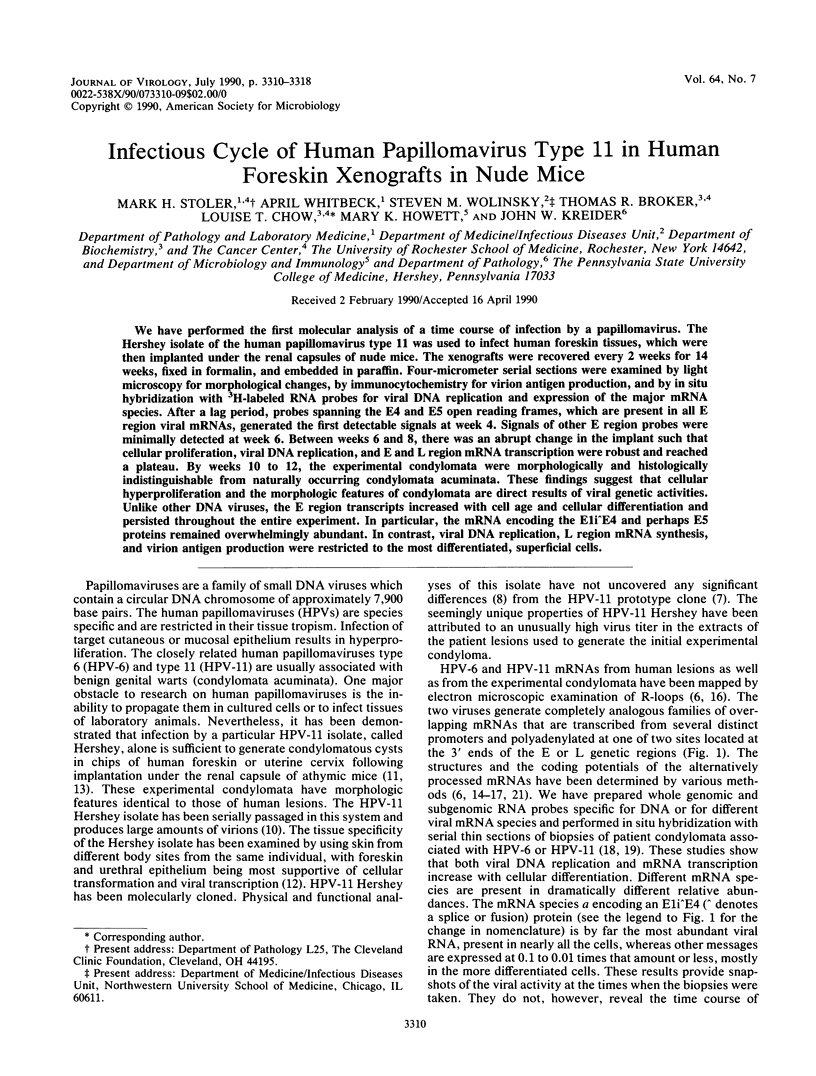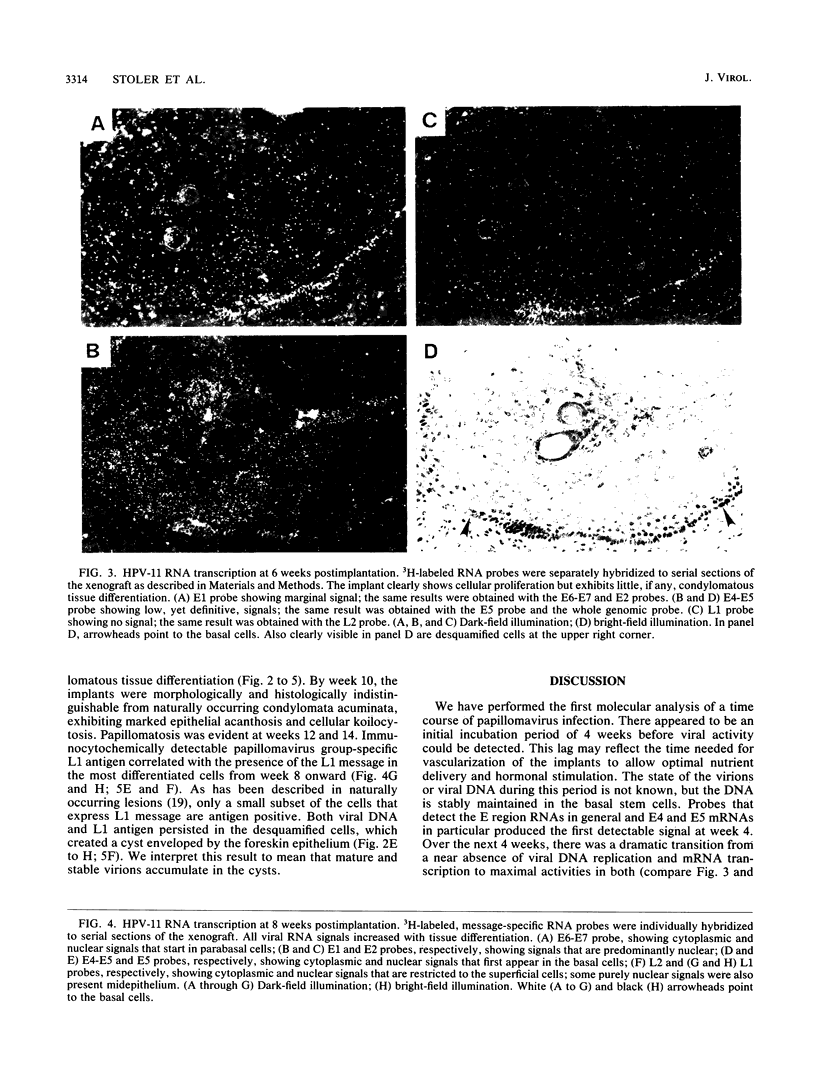Abstract
We have performed the first molecular analysis of a time course of infection by a papillomavirus. The Hershey isolate of the human papillomavirus type 11 was used to infect human foreskin tissues, which were then implanted under the renal capsules of nude mice. The xenografts were recovered every 2 weeks for 14 weeks, fixed in formalin, and embedded in paraffin. Four-micrometer serial sections were examined by light microscopy for morphological changes, by immunocytochemistry for virion antigen production, and by in situ hybridization with 3H-labeled RNA probes for viral DNA replication and expression of the major mRNA species. After a lag period, probes spanning the E4 and E5 open reading frames, which are present in all E region viral mRNAs, generated the first detectable signals at week 4. Signals of other E region probes were minimally detected at week 6. Between weeks 6 and 8, there was an abrupt change in the implant such that cellular proliferation, viral DNA replication, and E and L region mRNA transcription were robust and reached a plateau. By weeks 10 to 12, the experimental condylomata were morphologically and histologically indistinguishable from naturally occurring condylomata acuminata. These findings suggest that cellular hyperproliferation and the morphologic features of condylomata are direct results of viral genetic activities. Unlike other DNA viruses, the E region transcripts increased with cell age and cellular differentiation and persisted throughout the entire experiment. In particular, the mRNA encoding the E1iE4 and perhaps E5 proteins remained overwhelmingly abundant. In contrast, viral DNA replication, L region mRNA synthesis, and virion antigen production were restricted to the most differentiated, superficial cells.
Full text
PDF








Images in this article
Selected References
These references are in PubMed. This may not be the complete list of references from this article.
- Bedell M. A., Jones K. H., Grossman S. R., Laimins L. A. Identification of human papillomavirus type 18 transforming genes in immortalized and primary cells. J Virol. 1989 Mar;63(3):1247–1255. doi: 10.1128/jvi.63.3.1247-1255.1989. [DOI] [PMC free article] [PubMed] [Google Scholar]
- Brown D. R., Chin M. T., Strike D. G. Identification of human papillomavirus type 11 E4 gene products in human tissue implants from athymic mice. Virology. 1988 Jul;165(1):262–267. doi: 10.1016/0042-6822(88)90680-0. [DOI] [PubMed] [Google Scholar]
- Chin M. T., Broker T. R., Chow L. T. Identification of a novel constitutive enhancer element and an associated binding protein: implications for human papillomavirus type 11 enhancer regulation. J Virol. 1989 Jul;63(7):2967–2976. doi: 10.1128/jvi.63.7.2967-2976.1989. [DOI] [PMC free article] [PubMed] [Google Scholar]
- Chin M. T., Hirochika R., Hirochika H., Broker T. R., Chow L. T. Regulation of human papillomavirus type 11 enhancer and E6 promoter by activating and repressing proteins from the E2 open reading frame: functional and biochemical studies. J Virol. 1988 Aug;62(8):2994–3002. doi: 10.1128/jvi.62.8.2994-3002.1988. [DOI] [PMC free article] [PubMed] [Google Scholar]
- Chow L. T., Nasseri M., Wolinsky S. M., Broker T. R. Human papillomavirus types 6 and 11 mRNAs from genital condylomata acuminata. J Virol. 1987 Aug;61(8):2581–2588. doi: 10.1128/jvi.61.8.2581-2588.1987. [DOI] [PMC free article] [PubMed] [Google Scholar]
- Dartmann K., Schwarz E., Gissmann L., zur Hausen H. The nucleotide sequence and genome organization of human papilloma virus type 11. Virology. 1986 May;151(1):124–130. doi: 10.1016/0042-6822(86)90110-8. [DOI] [PubMed] [Google Scholar]
- Dollard S. C., Chow L. T., Kreider J. W., Broker T. R., Lill N. L., Howett M. K. Characterization of an HPV type 11 isolate propagated in human foreskin implants in nude mice. Virology. 1989 Jul;171(1):294–297. doi: 10.1016/0042-6822(89)90542-4. [DOI] [PubMed] [Google Scholar]
- Koller L. D., Olson C. Subcutaneous papillomatous cysts produced by bovine papilloma virus. J Natl Cancer Inst. 1971 Oct;47(4):891–898. [PubMed] [Google Scholar]
- Kreider J. W., Howett M. K., Leure-Dupree A. E., Zaino R. J., Weber J. A. Laboratory production in vivo of infectious human papillomavirus type 11. J Virol. 1987 Feb;61(2):590–593. doi: 10.1128/jvi.61.2.590-593.1987. [DOI] [PMC free article] [PubMed] [Google Scholar]
- Kreider J. W., Howett M. K., Lill N. L., Bartlett G. L., Zaino R. J., Sedlacek T. V., Mortel R. In vivo transformation of human skin with human papillomavirus type 11 from condylomata acuminata. J Virol. 1986 Aug;59(2):369–376. doi: 10.1128/jvi.59.2.369-376.1986. [DOI] [PMC free article] [PubMed] [Google Scholar]
- Kreider J. W., Howett M. K., Stoler M. H., Zaino R. J., Welsh P. Susceptibility of various human tissues to transformation in vivo with human papillomavirus type 11. Int J Cancer. 1987 Apr 15;39(4):459–465. doi: 10.1002/ijc.2910390409. [DOI] [PubMed] [Google Scholar]
- Kreider J. W., Howett M. K., Wolfe S. A., Bartlett G. L., Zaino R. J., Sedlacek T., Mortel R. Morphological transformation in vivo of human uterine cervix with papillomavirus from condylomata acuminata. Nature. 1985 Oct 17;317(6038):639–641. doi: 10.1038/317639a0. [DOI] [PubMed] [Google Scholar]
- Nasseri M., Hirochika R., Broker T. R., Chow L. T. A human papilloma virus type 11 transcript encoding an E1--E4 protein. Virology. 1987 Aug;159(2):433–439. doi: 10.1016/0042-6822(87)90482-x. [DOI] [PubMed] [Google Scholar]
- Rotenberg M. O., Chiang C. M., Ho M. L., Broker T. R., Chow L. T. Characterization of cDNAs of spliced HPV-11 E2 mRNA and other HPV mRNAs recovered via retrovirus-mediated gene transfer. Virology. 1989 Oct;172(2):468–477. doi: 10.1016/0042-6822(89)90189-x. [DOI] [PubMed] [Google Scholar]
- Rotenberg M. O., Chow L. T., Broker T. R. Characterization of rare human papillomavirus type 11 mRNAs coding for regulatory and structural proteins, using the polymerase chain reaction. Virology. 1989 Oct;172(2):489–497. doi: 10.1016/0042-6822(89)90191-8. [DOI] [PubMed] [Google Scholar]
- Smotkin D., Prokoph H., Wettstein F. O. Oncogenic and nononcogenic human genital papillomaviruses generate the E7 mRNA by different mechanisms. J Virol. 1989 Mar;63(3):1441–1447. doi: 10.1128/jvi.63.3.1441-1447.1989. [DOI] [PMC free article] [PubMed] [Google Scholar]
- Stoler M. H., Broker T. R. In situ hybridization detection of human papillomavirus DNAs and messenger RNAs in genital condylomas and a cervical carcinoma. Hum Pathol. 1986 Dec;17(12):1250–1258. doi: 10.1016/s0046-8177(86)80569-x. [DOI] [PubMed] [Google Scholar]
- Stoler M. H., Wolinsky S. M., Whitbeck A., Broker T. R., Chow L. T. Differentiation-linked human papillomavirus types 6 and 11 transcription in genital condylomata revealed by in situ hybridization with message-specific RNA probes. Virology. 1989 Sep;172(1):331–340. doi: 10.1016/0042-6822(89)90135-9. [DOI] [PubMed] [Google Scholar]
- Storey A., Pim D., Murray A., Osborn K., Banks L., Crawford L. Comparison of the in vitro transforming activities of human papillomavirus types. EMBO J. 1988 Jun;7(6):1815–1820. doi: 10.1002/j.1460-2075.1988.tb03013.x. [DOI] [PMC free article] [PubMed] [Google Scholar]
- Ward P., Mounts P. Heterogeneity in mRNA of human papillomavirus type-6 subtypes in respiratory tract lesions. Virology. 1989 Jan;168(1):1–12. doi: 10.1016/0042-6822(89)90397-8. [DOI] [PubMed] [Google Scholar]






